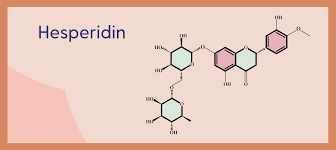
In the dynamic realm of skincare, natural ingredients are continuously gaining recognition. Researchers and formulators are keenly interested in plant-derived bioactives. Among these, Hesperidin and Glucosyl Hesperidin stand out.
These powerful flavonoids come primarily from citrus peels. They are celebrated for their strong antioxidant properties. They also offer a wide array of therapeutic benefits.
These include boosting microcirculation, reducing dark under-eye circles, and brightening the skin. They even support the vital skin barrier.
Whether your skin battles dullness, pigmentation, or inflammation, these natural compounds can help. They are also effective against under-eye fatigue.
They may unlock the secret to healthier, more radiant skin.
**Understanding Hesperidin and Glucosyl Hesperidin**
Let’s delve into what these compounds truly are.
**Hesperidin: A Potent Citrus Bioflavonoid**
Hesperidin is a naturally occurring flavanone glycoside. It is abundant in citrus fruits. Oranges, lemons, and grapefruits are rich sources. It is especially concentrated in the peel and white pith. These parts are often discarded during food preparation. Yet, they are invaluable in skincare chemistry.
Hesperidin belongs to the flavonoid family. Flavonoids are a type of polyphenolic compound. Hesperidin exhibits robust antioxidant properties. It also possesses anti-inflammatory and vasoprotective qualities.
Its structure includes the aglycone hesperetin. A sugar molecule, rutinose, is also part of its composition. This makes it a glycoside in its natural state.
**Glucosyl Hesperidin: An Enhanced, Water-Soluble Version**
Glucosyl Hesperidin is a biotechnologically modified form of hesperidin. A process called glucosylation adds a glucose molecule to hesperidin. This significantly boosts its water solubility.
It also dramatically improves skin penetration. These enhanced traits make it far more effective. It is also more stable for topical use in cosmetic formulas.
This modification does not diminish the compound’s antioxidant nature. Instead, it enhances its practical use. Formulators can easily incorporate it into various products.
Serums, creams, and under-eye treatments benefit greatly. These products achieve better skin absorption and deliver visible results.
**Skin Benefits of Hesperidin & Glucosyl Hesperidin**
Both compounds provide numerous cosmetic and dermatological advantages. They share similar functions. However, Glucosyl Hesperidin offers superior bioavailability. This means the skin absorbs it more readily.
It is also easier to formulate into products.
**1. Powerful Antioxidant Protection**
Hesperidin and its glucosylated counterpart effectively neutralize free radicals. These damaging molecules arise from sun exposure, pollution, and internal stress. Free radicals can harm skin cells. This leads to premature aging. They can also cause collagen breakdown and a weakened skin barrier.
By scavenging these free radicals, hesperidin helps prevent oxidative stress. Oxidative stress is a primary cause of dullness. It also contributes to fine lines and uneven skin tone.
**2. Anti-Inflammatory Effects**
Research indicates hesperidin suppresses pro-inflammatory cytokines. These include TNF-α, IL-1β, and IL-6. This property makes it excellent for calming skin.
It soothes sensitive, irritated, or inflamed skin. These conditions are often seen in rosacea, eczema, and acne. It also helps skin recovering from over-exfoliation.
**3. Improved Microcirculation**
One of hesperidin’s most exciting benefits is its ability to boost capillary strength. It also enhances blood flow. This improves nutrient delivery to the skin.
It effectively reduces under-eye puffiness and dark circles. This is especially true when poor circulation causes these issues.
**4. Skin Lightening and Brightening**
Both hesperidin and glucosyl hesperidin can inhibit tyrosinase. Tyrosinase is the key enzyme responsible for melanin production.
By reducing melanin synthesis, these ingredients lessen hyperpigmentation. They also help with melasma and post-inflammatory hyperpigmentation (PIH). They contribute to a more even skin tone.
**5. Barrier Repair and Moisture Retention**
Animal studies have shown hesperidin accelerates skin barrier repair. It also enhances filaggrin production. Filaggrin is crucial for healthy skin barrier function.
Furthermore, it promotes lipid synthesis. All these actions contribute to better moisture retention. They also improve skin resilience. This is particularly important for mature or dry skin types.
**6. UV Protection & Photoaging Prevention**
Pre-treatment with hesperidin has been shown to mitigate damage. It reduces the harmful effects of UVB and UVA rays. This has been observed in cell and mouse models.
It helps decrease lipid peroxidation and DNA damage. It also reduces protein carbonylation, inflammation, and erythema.
It further boosts the activity of natural antioxidant enzymes. These include superoxide dismutase (SOD) and catalase. This strengthens the skin’s internal defense system.
**Skin Concerns Addressed by Hesperidin & Glucosyl Hesperidin**
Their wide range of benefits makes these compounds highly versatile. They are increasingly found in formulations targeting specific skin concerns:
* Dark circles under the eyes
* Eye puffiness and tired-looking eyes
* Melasma and general hyperpigmentation
* Post-inflammatory hyperpigmentation (PIH)
* Redness and irritation from rosacea or acne
* Aging and dullness due to oxidative stress
* Barrier disruption from harsh treatments
They are commonly incorporated into various skincare products. These include eye creams, brightening serums, anti-aging lotions, and night repair treatments.
**How They Work in the Skin: Mechanisms of Action**
Let’s explore the scientific mechanisms behind their efficacy.
**1. Antioxidant & Free Radical Neutralization**
These compounds stabilize harmful free radicals. They achieve this by donating electrons. This prevents cellular and molecular damage. It helps maintain collagen structure. It also reduces signs of aging.
Furthermore, it provides protection against environmental stress.
**2. Anti-Tyrosinase Activity**
By inhibiting the tyrosinase enzyme, hesperidin reduces melanin formation. Melanin is the pigment responsible for dark spots and uneven skin tone.
**3. Barrier Support & Skin Renewal**
Topical application of these compounds shows several benefits. It increases lamellar body secretion. This is crucial for lipid delivery to the stratum corneum. It also boosts filaggrin expression. This helps build the skin’s outer barrier. Moreover, it normalizes skin pH. This supports a healthy microbial balance on the skin.
**4. Vasoprotective and Circulatory Support**
Hesperidin strengthens capillary walls. It also enhances microcirculation. This reduces vascular leakage and fluid buildup. This is vital for improving eye puffiness. It also helps with vascular-based dark circles.
**Research Highlights & Clinical Studies**
Scientific literature provides compelling evidence for these compounds.
**Epidermal Barrier Function**
Topical 2% hesperidin was applied twice daily. It accelerated barrier recovery in young and aged mice. It improved lipid production and epidermal differentiation. It also balanced the acid mantle.
In mice pre-treated with glucocorticoids, hesperidin normalized abnormal barrier recovery.
**UV Protection & Collagen Support**
Pre-treatment with hesperidin reduced UVA/UVB-induced DNA damage. This was observed in keratinocytes. It also reduced MMP (matrix metalloproteinase) expression. This helps preserve collagen structure. Furthermore, it encouraged collagen synthesis in dermal fibroblasts.
**Skin Cancer Potential**
In vitro studies suggest hesperidin can inhibit proliferation. It can also induce apoptosis in skin cancer cells. While not a cancer treatment, this potential highlights its protective role.
It also underscores its safety in skincare.
**Glucosyl Hesperidin vs. Hesperidin: Key Differences**
Understanding the distinctions is crucial for formulators and consumers.
| Feature | Hesperidin | Glucosyl Hesperidin |
| :—————– | :————————- | :—————————— |
| Source | Natural citrus flavonoid | Glucosylated form of hesperidin |
| Solubility | Poorly water-soluble | Highly water-soluble |
| Absorption | Lower | Higher skin absorption |
| Stability | Moderately stable | More stable in formulations |
| Ideal For | Serums, anti-aging creams | Eye creams, brightening products |
In summary, Glucosyl Hesperidin is generally preferred. This is true for most modern skincare formulations. Its increased solubility, enhanced penetration, and higher bioavailability make it superior.
**Safety and Tolerability**
Both hesperidin and glucosyl hesperidin are considered safe for topical application. They are non-sensitizing and non-irritating. They are generally well-tolerated. This applies even to sensitive skin types.
They are also suitable for use during pregnancy and breastfeeding. The Environmental Working Group (EWG) has not yet rated these ingredients individually.
However, no adverse effects have been reported in cosmetic use.
**How to Incorporate Hesperidin or Glucosyl Hesperidin into Your Skincare Routine**
Consider these tips if you wish to add these ingredients to your daily regimen.
**Look for Products Like:**
* Brightening eye creams for dark circles and puffiness
* Vitamin C serums paired with flavonoids for enhanced antioxidant defense
* Barrier repair creams for dry or irritated skin
* Treatments targeting melasma and other forms of hyperpigmentation
**Application Tips:**
Incorporate products containing these ingredients into your routine. They can be used daily, both morning and night. For eye creams, gently pat around the orbital bone.
For serums, apply a few drops to cleansed skin. Follow with a moisturizer. Consistency is key for visible results. Always patch test new products. This helps ensure no adverse reactions.
Consult a dermatologist for personalized advice. Especially if you have specific skin concerns.
**The Future of Citrus-Derived Bioactives in Skincare**
The research into hesperidin and glucosyl hesperidin is ongoing. Scientists are continually discovering new applications. Their natural origin makes them attractive.
Their powerful, multi-faceted benefits are also appealing. They represent a significant step forward in effective skincare. These citrus-derived compounds will likely become staples.
They will feature in many more advanced formulations. They offer a promising path to healthier, more resilient skin. Their potential is vast.
They embody the synergy between nature and scientific innovation. This duo is truly transforming modern skincare.


